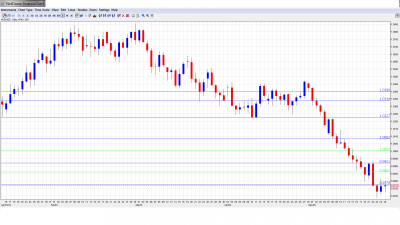The Australian dollar managed to hold steady this week, but has still lost around six cents against the US dollar in the month of May. The upcoming week is quite busy, with nine releases. Here is an outlook for the Australian events, and an updated technical analysis for AUD/USD.
AUD/USD has dropped sharply since the recent deep interest rate cut. The economy continues to suffer from the global slowdown, and the grim situation in the Euro-zone is weighing on the the aussie.
Updates: RBA Governor Stevens spoke in Sydney on Sunday. The markets seemed to like what he had to say, as the aussie has moved upwards, trading at 0.9870. Home Sales will be released on Tuesday. The markets are hoping to shake off the brutal -9.4% reading in April. The volatile Home Sales indicator did indeed rebound from last month’s reading, jumping 6.1%. The Australian dollar shrugged off the strong release, as AUD/USD was down, trading at 0.9835. Retail Sales, a key indicator, will be released on Wednesday. Retail Sales was down sharply, falling by 0.2%. The market forecast stood at increase of 0.2%. Construction Work Done rebounded nicely, jumping 5.5%. The aussie continues to sag, as AUD/USD was trading at 0.9762. Building Approvals plummeted by 8.7%, well below the market forecast of 0.3%. It was the indicator’s worst reading in 2012. Private Capital Expenditure climbed 6.1%, easily exceeding the market forecast of 4.1%. Private Sector Credit posted a 0.4% increase, a notch above the market estimate of 0.3%. AUD/USD has climbed above the 0.97 line, trading at 0.947.
AUD/USD graph with support and resistance lines on it. Click to enlarge:
-
RBA Gov Stevens Speaks: Sunday, 23:10. The markets will be keen to hear what the head of the central bank has to say, given the beating that the aussie has taken in the month of May. A speech that is considered more hawkish than expected is bullish for the Australian dollar.
- HIA New Home Sales: Tuesday, tentative. Traders should treat this index with caution, as it tends to be very volatile, which makes accurate forecasts difficult. The index contracted 9.4% in April, its biggest decline in over four years. Will the index recover and perform better in May?
- Retail Sales: Wednesday, 1:30. This key indicator jumped 0.9% in April, its best showing since last June. The markets are predicting a modest increase of 0.2% in May.
-
Construction Work Done: Wednesday, 1:30. This quarterly indicator tends to be volatile, and should be viewed with caution. The Q1 reading was awful, declining by 4.6%. Since November 2010, all readings except one have been below 1.0%, which is indicative of a weak construction sector. The markets are predicting better news in May, calling for an increase 3.1%.
-
Building Approvals: Thursday, 1:30. This indicator is also quite volatile, but as a key economic release, the markets pay close attention to it, and any unexpected figures can affect the direction of AUD/USD. The previous reading sparkled, jumping 7.4%. The markets are not expecting anything near a repeat performance, with a forecast of 0.7%.
-
Private Capital Expenditure: Thursday, 1:30. This quarterly indicator fell 0.3% in Q1, the first negative reading since November 2010. The market forecast calls for a much-improved reading of 4.1%.
-
Private Sector Credit: Thursday, 1:30. This indicator tends to show little movement, and the market forecasts tend to be quite accurate. The past two readings came in at 0.4%, indicating a modest increase in new credit given to consumers and businesses. Little change is expected in the May release.
-
AIG Manufacturing Index: Thursday, 23:30. This index dropped sharply in April, falling to 43.9 points. This was the second straight reading below the 50 level, indicating contraction in the manufacturing sector.
-
Chinese Final Manufacturing PMI: Friday, 1:00. This key index has been above 50 throughout 2012, indicating growth in the manufacturing committee. As China is Australia’s number 1 trading partner, an unexpected reading could affect the aussie.
-
Commodity Prices: Friday, 6:30. This indicator has been weakening since early 2011, and fell below the zero level in May, as it contracted by 4.2%. The indicator signals an export sector greatly weakened by decreased global demand.
* All times are GMT.
AUD/USD Technical Analysis
AUD/USD opened at 0.9837. The pair reached a high of of 0.9935, but then dropped sharply, falling as low as 0.9689, as the resistance line of 0.9668 (discussed last week) held firm. The pair rebounded somewhat, and pared some of its losses.
Technical levels from top to bottom:
With AUD/USD dropping sharply, we will adjust our support and resistance lines accordingly.
We begin with resistance at 1.0525, which was severely tested by the pair in March. Below, 1.0402, which was a fluid line for much of April, continues to provide strong resistance.
Close by, 1.0340 is the next line of resistance. Below, 1.0230, which had held firm in support since January, continues to provide resistance. This line has strengthened as AUD/USD trades at lower levels.
Next is the line of 1.0080, which had been protecting the all-important parity level since December 2011. This line was breached last week, and is now providing resistance to the pair.
Next, 0.9917 was breached this week by AUD/USD and is providing resistance. The next line is 0.9860, which is providing weak resistance. Below, the pair is getting weak support at 0.9780. This line is currently fluid, and looks to be tested by the pair. The next level of support is 0.9668, which has not been tested since March. This followed by strong support at 0.9541. Next is support just above the 0.94 level, at 0.9405. The final line for now is at 0.9294, which has provided AUD/USD with strong support since September 2011.
I am bearish on AUD/USD.
The Australian dollar continues to tumble, and has now dropped almost 6 six cents in the month of May. What’s next for the pair? US economic data continues to outshine the Australian releases. Given the ongoing crisis in the Euro-zone, investors will be favoring safe haven currencies, meaning that the greenback should continue to surge at the expense of the aussie.
The Aussie sometimes moves in tandem with gold. You can trade binary options on gold using this technical analysis.
Further reading:
- For a broad view of all the week’s major events worldwide, read the USD outlook.
- For EUR/USD, check out the Euro to Dollar forecast.
- For the Japanese yen, read the USD/JPY forecast.
- For GBP/USD (cable), look into the British Pound forecast.
- For the Australian dollar (Aussie), check out the AUD to USD forecast.
- For the New Zealand dollar (kiwi), read the NZD forecast.
- For USD/CAD (loonie), check out the Canadian dollar forecast.

